


Blockchain security is a fundamental and indispensable aspect of the blockchain technology landscape. As the adoption of blockchain continues to expand across industries, understanding the intricacies of its security becomes paramount. At its core, blockchain security encompasses the measures and mechanisms that safeguard the integrity of data and transactions within a decentralized and transparent ledger. It addresses a wide array of threats, from unauthorized access and data tampering to fraud and cyberattacks.
This introduction explores the multifaceted realm of blockchain security, delving into its foundational principles, key components, and the challenges it faces. By comprehending the inner workings of blockchain for security, individuals and businesses can harness the technology’s full potential while navigating the evolving landscape of digital trust and data protection. Whether you are an enthusiast, a professional, or an organization seeking to leverage blockchain’s potential, a firm grasp of blockchain security is indispensable in today’s digital age.
A blockchain is a groundbreaking technology that has redefined the way data is stored, secured, and managed in the digital age. At its core, a blockchain is a distributed, decentralized, and immutable digital ledger that records transactions and data across a network of interconnected computers.
Unlike traditional centralized databases, which rely on a single authority for control and validation, a blockchain operates on a peer-to-peer network, offering unprecedented levels of transparency, trust, and security.
The term “blockchain” is derived from the way data is structured within this system. Information is grouped into blocks, and each block contains a set of transactions. These blocks are linked in chronological order to form a continuous chain, hence the name “blockchain.” Once a block is added to the chain, it becomes virtually impossible to alter or delete the data it contains, making it highly secure and tamper-resistant.
Blockchain technology gained prominence with the advent of Bitcoin, a digital cryptocurrency that uses a blockchain to record all transactions. However, its applications extend far beyond digital currencies. Blockchain has found uses in supply chain management, healthcare, finance, voting systems, and various other industries where the transparency and security of data are paramount.
In essence, a blockchain is a revolutionary tool that holds the potential to transform various aspects of our digital world, providing a secure and transparent framework for countless applications and industries. Understanding the fundamentals of what a blockchain is forms the foundation for harnessing its innovative potential.
Blockchain is widely acknowledged for its remarkable security, a characteristic that stems from its foundational principles and cryptographic methodologies. Several factors contribute to the remarkable security of blockchain.
Key element is decentralization, in stark contrast to conventional systems that rely on central authorities, creating potential single points of failure. Blockchain operates on a decentralized network of nodes, relying on consensus through majority agreement, thereby eliminating centralization risks.
Another essential aspect is immutability. Once data is recorded on a blockchain, it becomes nearly impervious to alteration. This immutability is established through cryptographic hashing, with each block referencing the previous one, thereby creating a chain that is resistant to modification without affecting all subsequent blocks.
Cryptography plays a pivotal role in securing data and transactions within the blockchain. Cryptographic hashing preserves data integrity, while digital signatures authenticate users and validate their authorization, thus averting unauthorized access.
Transparency is a fundamental feature of blockchain. The ledger is transparent, enabling all network participants to validate transactions. This transparency diminishes the risk of fraud and fosters trust since every transaction is publicly visible and independently verifiable.
The consensus mechanisms employed by blockchain, such as Proof of Work (PoW) and Proof of Stake (PoS), are crucial for validating transactions and ensuring network security. These mechanisms are resource-intensive and energy-consuming, making it exceptionally challenging for malicious actors to manipulate the system.
Blockchains and traditional databases present distinctive security paradigms, each tailored to specific use cases and organizational needs. Blockchains, celebrated for their robust security features, are characterized by decentralization, immutability, and transparency. These attributes make them exceptionally secure for applications requiring high data integrity, such as financial transactions or medical records.
Decentralization ensures there’s no single point of failure, making it extremely challenging for malicious actors to compromise the system. Immutability guarantees that once data is recorded, it’s nearly impossible to alter, enhancing security and trust. Additionally, cryptographic techniques safeguard data and transactions, while transparency allows all participants to validate activities, fostering accountability and fraud detection.
Traditional databases, on the other hand, are often centralized and controlled by a single entity. While this central authority can enforce security measures, it also represents a single point of attack, making them vulnerable to breaches. Access to traditional databases is permission-based, allowing authorized individuals or entities to interact with data.
While this can be an advantage, unauthorized access can lead to security vulnerabilities. Traditional databases may also lack the redundancy seen in blockchains, meaning a catastrophic failure or breach can result in significant data loss. However, they offer flexibility in implementing customized security measures tailored to an organization’s needs.
The choice between blockchains and traditional databases hinges on the specific security requirements of a given use case. Organizations must weigh the benefits of decentralization and immutability offered by blockchains against the customization and control available with traditional databases to determine the best fit for their security needs.
Security in the realm of blockchain can vary significantly depending on the specific type or design of the blockchain. While the core principles of decentralization and cryptographic security are shared, different blockchain types employ distinct consensus mechanisms and governance structures that influence their security profiles.
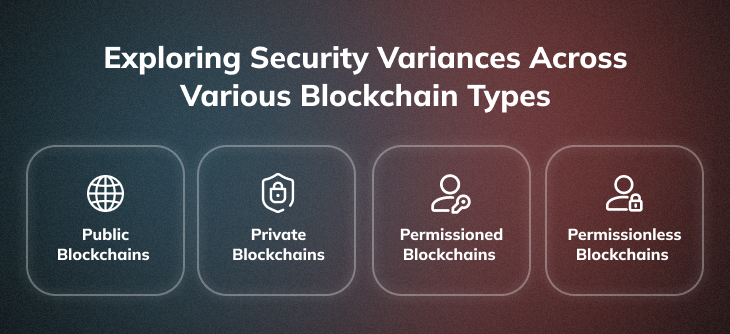
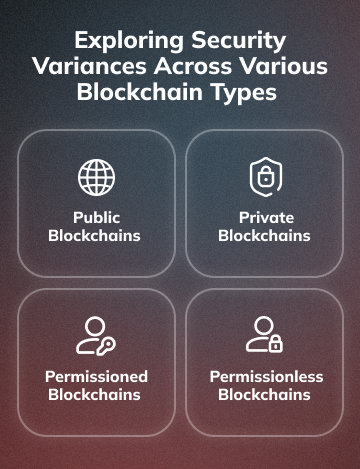
Public blockchains, like Bitcoin and Ethereum, are open and permissionless. Security in these networks relies on a large number of distributed nodes reaching consensus through mechanisms like Proof of Work (PoW) or Proof of Stake (PoS). Their open nature makes them resilient against censorship, but they can be vulnerable to 51% attacks if a single entity gains majority control over the network.
Private blockchains are more centralized, with restricted access to authorized participants. They offer enhanced privacy and control, making them suitable for business applications. Security primarily depends on the trustworthiness of network participants, potentially making them less secure if participants are compromised or colluded.
Permissioned blockchains require participants to be authenticated and authorized. They are highly secure but lack the censorship resistance of public chains. Security stems from controlled access and trust in authorized participants.
As the name implies, are open to anyone without requiring permission to participate. They are characterized by a high degree of decentralization and security through consensus mechanisms like Proof of Work (PoW) or Proof of Stake (PoS). Security in permissionless blockchains is maintained by a large and diverse network of participants who validate and record transactions, making them resistant to censorship and central control.
The security of a blockchain type depends on its consensus mechanism, governance, and who can participate. Public blockchains prioritize decentralization but can be vulnerable to certain attacks, while private and permissioned blockchains emphasize control and trust but may sacrifice some aspects of decentralization. Selecting the most appropriate blockchain type should be based on the specific security requirements of the use case.
In the modern business landscape, security is paramount, and blockchain technology has emerged as a powerful ally. This section delves into the myriad advantages that blockchain offers to fortify security in business operations. From its decentralized structure to the immutable ledger, cryptographic protection, and transparency, blockchain has become a trusted tool for safeguarding sensitive data, transactions, and business relationships. Exploring these benefits underscores the transformative potential of blockchain in the realm of business security.
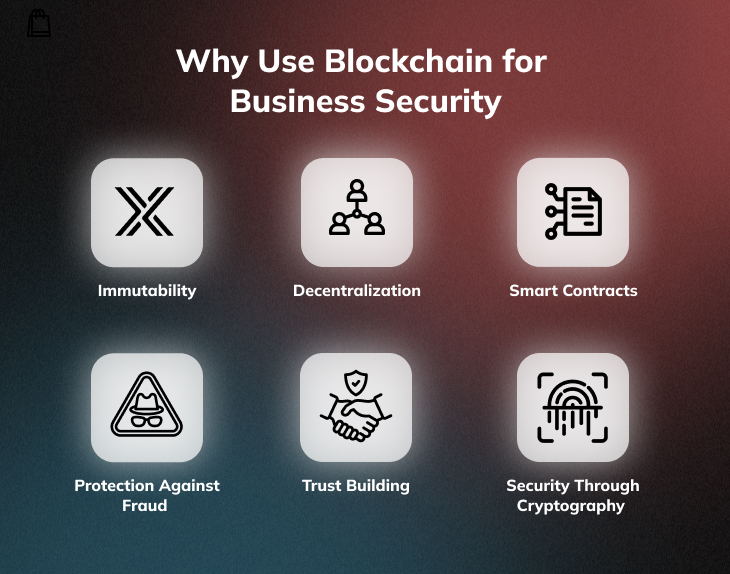
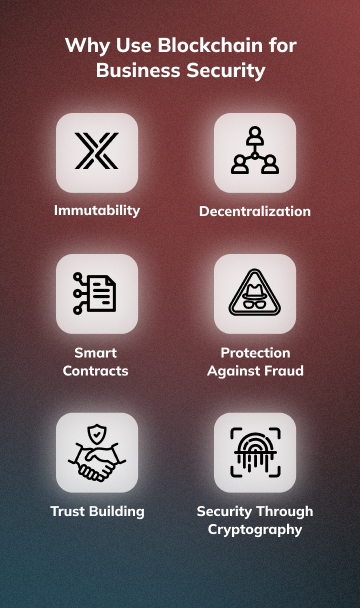
Immutability in blockchain means that once data is recorded, it cannot be changed or erased. This is achieved through cryptographic hashing, where data is assigned a unique, irreversible code based on its content. Even minor alterations result in entirely different codes, making tampering easily detectable. In a blockchain, data is organized in linked blocks, with each block referencing the previous one. This creates a secure, chronological chain, making it virtually impossible to modify one block without altering all subsequent blocks, ensuring data integrity and security.
Decentralization is a fundamental feature of blockchain for security, where control is distributed across a network of nodes rather than concentrated in a central authority. This structure eliminates single points of failure and reduces the risk of a system-wide collapse. Decentralization fosters resilience and security, as no single entity has undue influence or access to all the data. It’s a key element in the blockchain’s resistance to censorship and unauthorized manipulation, making it particularly valuable in enhancing security, trust, and transparency in various business applications.
Smart contracts are self-executing agreements in blockchain, automating and enforcing terms and conditions without the need for intermediaries. These contracts are written in code and execute actions when predefined conditions are met. They offer transparency, security, and trust by eliminating the risk of manual errors or manipulation. Smart contracts find applications in areas like supply chain management, financial services, and legal processes, streamlining business operations and reducing the risk of contract breaches while enhancing security and efficiency.
Blockchain provides robust protection against fraud due to its inherent security features. Immutability ensures that once a transaction is recorded, it cannot be altered or deleted, making fraud detection straightforward. Transparency allows all participants to verify transactions, making fraudulent activities highly visible. Decentralization and consensus mechanisms reduce the risk of unauthorized access or manipulation. This makes blockchain an effective tool for preventing and detecting fraudulent activities, making it valuable in industries prone to fraud, such as finance, healthcare, and supply chain management.
Blockchain fosters trust among stakeholders by offering a transparent, tamper-resistant platform. Immutability ensures that recorded data remains unchanged, enhancing confidence in the integrity of information. Transparent transactions allow all participants to validate activities, reducing the need for intermediaries and fostering trust in peer-to-peer interactions. This trust-building element is particularly valuable in business relationships, where transparency and security are vital. Blockchain enhances trust between partners, customers, and clients, making it a powerful tool for building and maintaining credibility.
Blockchain’s security is fortified through robust cryptographic techniques. Data and transactions are secured through cryptographic hashing and digital signatures. Cryptographic hashing generates unique codes for each piece of data, ensuring data integrity, while digital signatures provide authentication and authorization, preventing unauthorized access. This cryptographic security makes it exceedingly difficult for malicious actors to compromise the system, enhancing the overall security of blockchain. It is a crucial component of blockchain’s trustworthiness, protecting sensitive data and transactions in various industries, including finance and healthcare.
Blockchain technology, often celebrated for its security and immutability, is not impervious to cyber vulnerabilities. This overview highlights various risks and security challenges within blockchain networks, along with real-world incidents, revealing that even this advanced technology can be susceptible to compromise and cyberattacks.
Phishing attacks are a significant security threat where attackers deceive users into revealing sensitive credentials or private keys. Typically conducted through emails or fake websites mimicking legitimate blockchain services, these attacks aim to gain unauthorized access to users’ digital wallets or accounts. Once the attacker obtains this information, they can steal cryptocurrencies or other digital assets. Raising awareness and implementing strong security practices are vital to protect users against these deceptive and potentially damaging phishing attacks in the blockchain space.
Code exploitation attacks target vulnerabilities within the blockchain’s smart contracts or underlying software. Attackers exploit flaws in code to manipulate contract functions, steal cryptocurrencies, or disrupt network operations. These vulnerabilities often stem from poor coding practices or overlooked security gaps during development. Preventing such attacks requires rigorous code audits, thorough security protocols, and continuous monitoring for anomalies. Addressing these vulnerabilities is critical to safeguard the integrity and security of blockchain networks and their associated transactions.
Routing attacks pose a significant threat to network security. These attacks involve intercepting and manipulating the data packets transmitted between nodes in the blockchain network. Attackers can delay or block the transmission of these packets, disrupting the consensus process and potentially leading to double spending or network partitioning. Such attacks exploit the vulnerabilities in internet routing infrastructure, emphasizing the need for robust encryption and secure communication protocols to safeguard blockchain data as it traverses the network.
Sybil attacks occur when an attacker creates multiple false identities to gain a disproportionate influence within the network. By creating numerous nodes, the attacker can subvert the network’s operations, such as disrupting consensus mechanisms or interrupting legitimate network activities. This type of attack exploits the decentralized nature of blockchain, where trust is distributed among many users. Defending against Sybil attacks is crucial for maintaining the integrity, security, and reliability of blockchain networks.
A 51% attack on blockchains is a significant security concern, particularly for smaller, less established networks. It occurs when a single entity or group gains control of more than 50% of the network’s mining power, enabling them to manipulate the blockchain. Such control allows them to halt new transactions, reverse completed transactions (double spending), and prevent other miners from completing blocks. This undermines the blockchain’s integrity and trustworthiness, posing a critical risk to its stability and user confidence.
In recent years, blockchain technology has transitioned from a theoretical concept to a practical tool, with numerous companies successfully harnessing it to fortify security across diverse industries. From supply chain transparency and food safety assurance to more efficient financial services and secure cryptocurrency trading, these examples highlight the versatile ways blockchain is revolutionizing security and fostering trust in a wide array of business applications.
IBM has been a trailblazer in blockchain adoption, emphasizing trust and security in its applications. The company’s Food Trust platform revolutionizes food supply chains by tracking the journey of products, maintaining detailed records at every step. This boosts transparency and reduces food fraud, providing consumers with real-time access to product origins. Additionally, IBM’s blockchain-based digital identity solutions offer secure and efficient identity verification, protecting sensitive personal information while simplifying authentication processes for users across various applications, from healthcare to financial services.
J.P. Morgan has significantly embraced blockchain technology through its development of Quorum, a private blockchain platform. The financial giant employs Quorum to enhance the security and efficiency of financial services, particularly in securities transactions and settlements. By automating complex financial processes and enabling real-time settlement, J.P. Morgan reduces errors and costs while enhancing data security. Quorum’s privacy features are advantageous for confidential financial transactions, further establishing the bank as a pioneer in secure blockchain applications within the financial industry.
Walmart, the retail giant, utilizes blockchain technology to enhance food safety and supply chain transparency. Through its participation in the IBM Food Trust initiative, Walmart ensures that food products’ origins and journey are tracked securely on the blockchain. This enables quick identification of the source of contaminated products, reducing the risk of foodborne illnesses. By promoting transparency and security, Walmart demonstrates its commitment to providing safe, high-quality products to customers, reinforcing trust in its supply chain operations.
Binance, one of the world’s largest cryptocurrency exchanges, has successfully integrated blockchain technology to ensure secure and transparent cryptocurrency trading. The platform records all transactions on the blockchain, offering users an immutable and verifiable history of their digital asset holdings and trades. Binance places a strong emphasis on security, implementing multi-factor authentication, cold storage of funds, and regular security audits to protect users’ assets. The combination of transparency and robust security measures has contributed to Binance’s reputation as a trusted cryptocurrency exchange.
Coinbase is a prominent cryptocurrency exchange renowned for its robust security measures. It employs advanced safeguards, including multi-signature wallets, which require multiple authorizations for fund access, reducing the risk of unauthorized withdrawals. To further enhance security, Coinbase stores the majority of users’ cryptocurrency holdings in offline cold storage, protecting them from online threats. Routine security audits and insurance coverage for digital assets add an extra layer of protection, reinforcing Coinbase’s commitment to safeguarding users’ funds and maintaining their trust.
Blockchain security solutions are pivotal for safeguarding business operations and data in an increasingly digital world. From access control and decentralization to cryptographic measures and smart contracts, these solutions offer a multifaceted approach to protect against cyber threats, fraud, and data breaches. We’ll explore various blockchain security measures that businesses can employ to enhance the integrity and security of their operations.
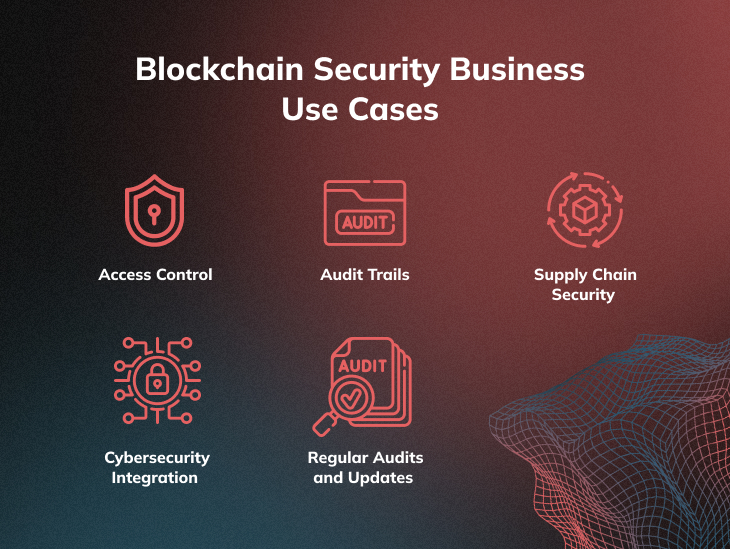
Access control is a fundamental blockchain security solution measure that dictates who can access and modify data on the network. It is enforced through a combination of authentication and authorization mechanisms, such as private keys, digital signatures, and cryptographic keys. Access control ensures that only authorized individuals or entities have the right permissions to interact with the blockchain. By defining and restricting access, businesses can safeguard sensitive data, reduce the risk of unauthorized changes, and bolster security in blockchain applications, including financial transactions, supply chain management, and digital identity verification.
Audit trails are a core component of blockchain data security, offering businesses an indelible record of all activities on the network. Each transaction and data entry is time-stamped, cryptographically secured, and linked in a chronological chain. This transparency enhances accountability, making it easy to track changes, detect fraudulent activities, and meet regulatory compliance. Audit trails are invaluable for businesses requiring a robust record-keeping system, such as those in finance, healthcare, and supply chain management, where data integrity is paramount.
Supply chain security is a critical application of blockchain technology. It involves tracking and verifying the origin and journey of products throughout the supply chain. Blockchain ensures transparency and trust by recording every step, from manufacturing to delivery. This reduces the risk of counterfeit goods, enhances product quality, and bolsters consumer trust. It’s particularly beneficial for industries like food, pharmaceuticals, and luxury goods, where product authenticity and safety are paramount, and for businesses seeking to streamline their supply chain operations while improving security.
Cybersecurity integration is the amalgamation of traditional cybersecurity practices with blockchain technology to bolster security. By combining established tools like firewalls, intrusion detection systems, and encryption with the inherent security features of blockchain, businesses can enhance their defense against a wide array of cyber threats. This integration safeguards against Distributed Denial of Service (DDoS) attacks, malware, and social engineering, creating a comprehensive security framework that offers robust protection to business operations and sensitive data.
Regular audits and updates are essential for maintaining the security of a blockchain network. Audits involve comprehensive assessments of the network to identify vulnerabilities, potential threats, or areas in need of improvement. Updates refer to the application of patches, enhancements, or changes to the blockchain software to mitigate identified risks and ensure the network remains resilient. These practices are crucial for adapting to evolving security challenges, enhancing network integrity, and maintaining the trust of stakeholders and users.
Blockchain technology has gained prominence for its potential to revolutionize various industries. However, it also faces several challenges that must be addressed to fully realize its potential.
Scalability in blockchain refers to the network’s ability to handle a growing number of transactions without sacrificing speed or efficiency. The challenge lies in accommodating increased workloads while maintaining decentralization and security. Solutions include off-chain scaling techniques like the Lightning Network and layer 2 solutions, as well as on-chain strategies such as sharding, which divides the blockchain into smaller, manageable parts. Balancing scalability with security remains a fundamental concern in the blockchain space.
Interoperability is the capacity of different blockchain networks to communicate and share data seamlessly. In the blockchain world, multiple networks often operate in isolation, hindering data exchange. Interoperability solutions, like cross-chain protocols and bridges, enable diverse blockchains to connect and work cohesively. This capability is crucial for realizing the full potential of blockchain technology, allowing the efficient transfer of assets and information across different chains.
Energy consumption is a critical concern, especially in blockchains that use Proof of Work (PoW) consensus mechanisms, such as Bitcoin. PoW requires significant computational power and, consequently, substantial energy. To address this issue, some blockchains are transitioning to more energy-efficient consensus mechanisms like Proof of Stake (PoS). These mechanisms reduce the environmental impact while maintaining the blockchain network security, making the technology greener and more sustainable.
Adoption barriers in blockchain technology often stem from resistance to change and lack of awareness. Blockchain’s complexity, coupled with the absence of user-friendly interfaces, can deter mass adoption. Education and awareness campaigns, combined with user-friendly applications and simplified onboarding processes, are vital in breaking down these barriers. Clear value propositions, cost-efficiency, and regulatory clarity are also key factors in driving broader adoption and ensuring blockchain’s full potential is realized across various industries.
Blockchain security is a game-changer in the world of digital trust and data protection. Its inherent features, including decentralization, immutability, and robust cryptographic measures, make it one of the most secure systems available. Blockchain’s ability to create an indelible ledger, resistant to tampering or fraud, instills unparalleled confidence.
While challenges exist, the ongoing development and commitment to innovation in the blockchain space reinforce its position as a beacon of trust and data security. As it matures and adapts, blockchain security testing is poised to revolutionize how we secure digital information, offering an exceptionally secure and transparent foundation for the future of business and personal data protection.
These are some of the most common questions that people are asking, particularly for blockchain security. These queries encompass key aspects of this vital field, shedding light on the areas of interest and concern for those exploring the world of secure blockchain technology.
Blockchain security refers to the measurements set in place to reduce potential attacks and to ensure the overall security of all data and user activity within the blockchain network. Thanks to these security measures, many businesses within many industries can profit from the technology. For example, the music industry can benefit from blockchains and the Web3 world by providing tokenized tickets, merch and music. The sports industry can also do the same, but also introduce collectibles in tokenized form like NFT collectible cards. Many industries have the opportunity to tap into this beneficial world, even restaurants, supply chain management providers and digital art.
Blockchains can be used both for their security and because of their security. There are four different types of blockchains – public, private, permissioned and permissionless blockchains. Private, and permissioned blockchains enable the authorities controlling them to decide who has access to what type of information, additionally to when and how that information is accessed. They have private networks and new members are selected by that network. This is a very stable structure of security that blockchains have and one of the reasons why they are so entrusted by users because of it. Furthermore, they have various security measures implemented to provide additional security layers, like the Two-Factor Authentication (2FA) and smart contracts.
There are many great use cases for successful blockchain implementation within different businesses. One such is that of Walmart Canada which saw a problem within its transportation due to large data inconsistencies in the invoice and payment processes of its (and third party) carriers. Walmart successfully fixed the issue through a blockchain system which automated the management of invoices and payments.
Another great example is that of the National Health Service (NHS) Wales, UK along with their collaborators Roche Diagnostics, Digipharm and Life Sciences Hub Wales. They used Digipharm’s blockchain platform to build a payment-by-result contracting model to pioneer sustainable procurement within the healthcare industry. The goals are for patients to face shorter wait times, quicker diagnostics and an overall fairer payment structure for the provided services. Again, all thanks to the secure and reliable technology behind blockchains.